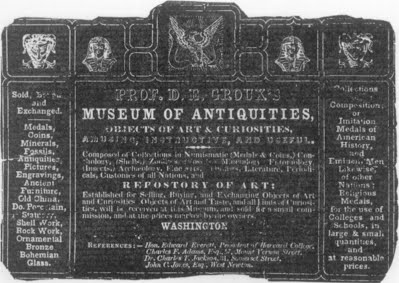
PREV ARTICLE
NEXT ARTICLE
FULL ISSUE
PREV FULL ISSUE
EDOUARD DANIEL JACOB GROUX (1807-1874)
John Lupia submitted the following information from the online draft of his book of numismatic biographies for this week's installment of his series. Thanks! As always, this is an excerpt with the full article and bibliography available online. This week's subject is collector/dreamer extraordinaire,
Daniel E. Groux.
-Editor
His first marriage was on August 28, 1825, to Pauline Josephine Adele Des Champs, at Westminster, England. They had a daughter Desiree C. Groux. In 1839, Groux acquired a second coin collection of 2,800 pieces collected over a period of 40 years by Dr. Lemner, Librarian of the Ambrosian Museum, Innsbruck. Groux bought the collection from Lemner's son who inherited it. In 1841, at Marseilles, Group had amassed a collection of over 8,000 coins and medals. The American Consul ill advised him to sell the collection to the American government. In 1844, Groux arrived in America settling at Boston, Massachusetts. French pastry chef, numismatist, adventurer, and pretensive opportunist who moved to Boston, and later on to Washington, D.C. Fluent in four languages he translated several works into English and offered his services as a language instructor. The 1845 and 1846 correspondence of D.E. Groux, a noted collector of the time, offered his "valuable cabinet of coins and medals", numbering 8,272 pieces, for sale "at a low price" to the Institute. Unfortunately, the Institute, as well as its successor, the Smithsonian Institute, did not have the necessary funds to take advantage of this favorable offer. In August 1846, Groux pawned his coin collection in New York. He asked Charles Francis Adams of Boston for a loan to redeem his collection. Adams made seven loans from September 1846 to June 1847 totaling $233. Adams kept hundreds of coins as collateral on the loan. He discovered over time many of these coins were scarce and rare and unavailable in America. Allen C. Cooper, a Boston attorney loaned Groux $155 using a wooden box filled with 1,620 silver coins, and an additional 2,626 in copper and brass. Beginning in 1848 he held a number of coin auctions that realized very little money. His second marriage was to Mary (1833-) at Massachusetts. He is listed in the 1849 Boston City Directory as a teacher of German and French residing at 2-1/2 Green Street.

Daniel E. Groux's business card or trading label. In 1850, he moved to Washington, D.C. In 1851, Groux persuaded Rep. John L. Conger of Michigan to introduce a bill into the House a petition by Daniel E. Groux asking Congress to buy his coin collection of 6,537 pieces for the Library of Congress. In 1851, Groux catalogued the coin collection of General Nathan Towson : The Towson Cabinet of Medals and Coins, which the following year was donated to the Maryland Historical Society. Author of Numismatic History of the United States (unpublished planned as 3 volumes, and believed to be incomplete), whose collection sold by lottery on February 15, 1856 sale by Bangs. He issued a 16-page catalog of coins for sale on December 1, 1855, not cited by Attinelli as a real coin auction catalogue, but as a catalogue of coins. In 1856, Groux sued Charles Francis Adams for fraud by failing to return the coin collection when payment in full was made on the loan. Groux asserted the collection was worth $10,000. The trial of Groux v. Adams reads like a romantic fiction enthralling numismatic readers with amazing entertainment. The defense attorney brought in Boston coin dealer Henry Davenport as an expert witness testifying on the value of the collection. Davenport showed in specific examples of coins how over evaluated Groux assessed his own collection. Davenport stated, for example, he possessed a Cromwell crown superior in every way paying 2 pounds 5 shillings when in London recently. The inferior specimen owned by Groux was valued at $400, the same coin previously valued by Groux in 1851 for $50. Groux lost and was found guilty of perjury. Adams sold the collection to Winslow Lewis. Groux hoped to become employed by the Director of the Smithsonian, Joseph Henry. Unfortunately, Henry was informed about the Boston lawsuit with Adams and did not hire him. Dejected and unable to find employment he went to Philadelphia. There was arrested and released. On December 30, 1868, Charles Francis Adams, wrote in his diary on returning to his coin collection after many years he was amazed at how many rare and valuable coins he amassed and could not recall where he got them. Groux died heavily in debt and his estate only brought $1,452.00 in an auction in 1874.
To read the complete article, see:
The entire inventory of the Lupia Numismatic Library is for sale. Individual items will be available before the remaining archives are broken up into parcels sold at philatelic auctions in the U. S. and Hong Kong. Check NumismaticMall.com frequently as dozens of new items with estimates will be posted daily until everything is sold. All inquiries will be given prompt and courteous attention. Write to: john@numismaticmall.com .

Wayne Homren, Editor The Numismatic Bibliomania Society is a non-profit organization promoting numismatic literature. See our web site at coinbooks.org. To submit items for publication in The E-Sylum, write to the Editor at this address: whomren@gmail.com To subscribe go to: https://my.binhost.com/lists/listinfo/esylum All Rights Reserved. NBS Home Page Contact the NBS webmaster 
|
